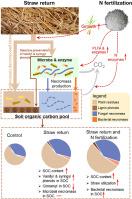Soil Biology and Biochemistry ( IF 9.8 ) Pub Date : 2023-10-22 , DOI: 10.1016/j.soilbio.2023.109223 Xiangtian Meng , Xuechen Zhang , Yunuo Li , Yapeng Jiao , Lichao Fan , Yuji Jiang , Chunyan Qu , Ekaterina Filimonenko , Yuhan Jiang , Xiaohong Tian , Jianglan Shi , Yakov Kuzyakov

|
Carbon (C) and nitrogen (N) inputs strongly influence the formation, turnover and sequestration of soil organic carbon (SOC) in agricultural ecosystems. It is not clear, however, how N input regulates the contribution of plant- and microbial-derived C to SOC sequestration under straw return. To fill this gap, plant and microbial biomarkers, as well as enzyme activities were determined in a long-term (18 years) field experiment. Straw return and N fertilization increased SOC content by 20% and 10%, respectively. Specifically, straw return increased the proportion of total lignin (mainly vanillyl and syringyl) phenols in SOC by 16%, but decreased the proportion of cinnamyl in SOC by 7.5%. This implied that some plant residues were selectively preserved, while the compounds that were less stable than cinnamyl were easily decomposed. The increased phospholipid fatty acid (PLFA) content and enzyme activities with straw return indicated the acceleration of straw decomposition. Based on amino sugar content, straw return did not alter the proportion of microbial necromass to SOC. Together, lignin and amino sugars co-determined the stable contribution of plant- and microbial-derived C to SOC sequestration under straw return. N fertilization increased the portion of microbial necromass (especially bacterial necromass) C in SOC by 6% and thus decreased the plant residue contribution to SOC. Accordingly, N fertilization accelerated the microbial utilization of straw and consequently microbial necromass formation. In terms of PLFA composition, Ascomycota and Basidiomycota, Actinobacteria, and Gram-negative bacteria were the key groups forming microbial necromass and thus SOC. N fertilization increased N-acquiring enzyme activities and boosted the involvement of microbial necromass in nutrient cycling, which in turn may stimulate plant and microbial growth. Overall, straw return simultaneously increased plant- and microbial-derived C, while N fertilization stimulated microbial growth and enzyme activity and thus increased straw conversion to microbial necromass.
中文翻译:

氮肥在秸秆还田下主要通过微生物坏死物形成来积累土壤有机碳
碳(C)和氮(N)输入强烈影响农业生态系统中土壤有机碳(SOC)的形成、周转和封存。然而,尚不清楚氮输入如何调节秸秆还田下植物和微生物来源的碳对 SOC 封存的贡献。为了填补这一空白,我们在长期(18 年)的田间实验中测定了植物和微生物生物标志物以及酶活性。秸秆还田和施氮肥分别使 SOC 含量增加 20% 和 10%。具体而言,秸秆还田使总木质素(主要是香草基和紫丁香基)酚在SOC中的比例增加了16%,但使肉桂基在SOC中的比例下降了7.5%。这意味着一些植物残留物被选择性保留,而比肉桂基稳定性差的化合物很容易分解。秸秆还田后磷脂脂肪酸(PLFA)含量和酶活性增加,表明秸秆分解加速。根据氨基糖含量,秸秆还田并没有改变微生物坏死物与 SOC 的比例。木质素和氨基糖共同决定了植物和微生物来源的 C 对秸秆还田下 SOC 封存的稳定贡献。施氮肥使微生物坏死物(特别是细菌坏死物)C在SOC中的比例增加了6%,从而降低了植物残留物对SOC的贡献。因此,施氮肥加速了秸秆的微生物利用,从而加速了微生物坏死物的形成。就PLFA组成而言,子囊菌门和担子菌门、放线菌门和革兰氏阴性菌是形成微生物坏死物和SOC的关键群体。施氮肥增加了获取氮的酶活性,并促进了微生物坏死物参与养分循环,这反过来又可能刺激植物和微生物的生长。总体而言,秸秆还田同时增加了植物和微生物来源的碳,而施氮肥刺激了微生物生长和酶活性,从而增加了秸秆向微生物坏死物的转化。


















































 京公网安备 11010802027423号
京公网安备 11010802027423号